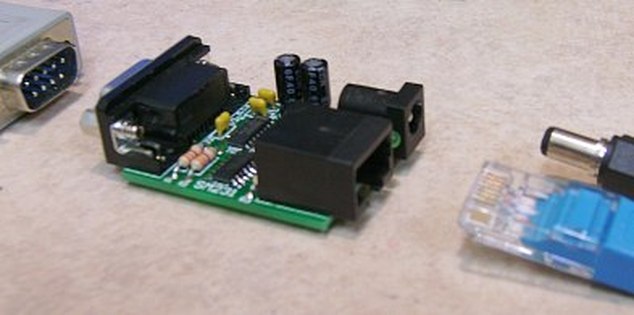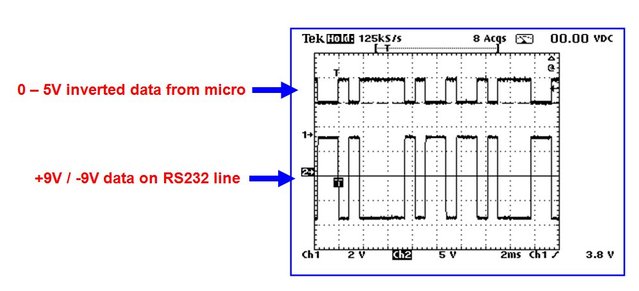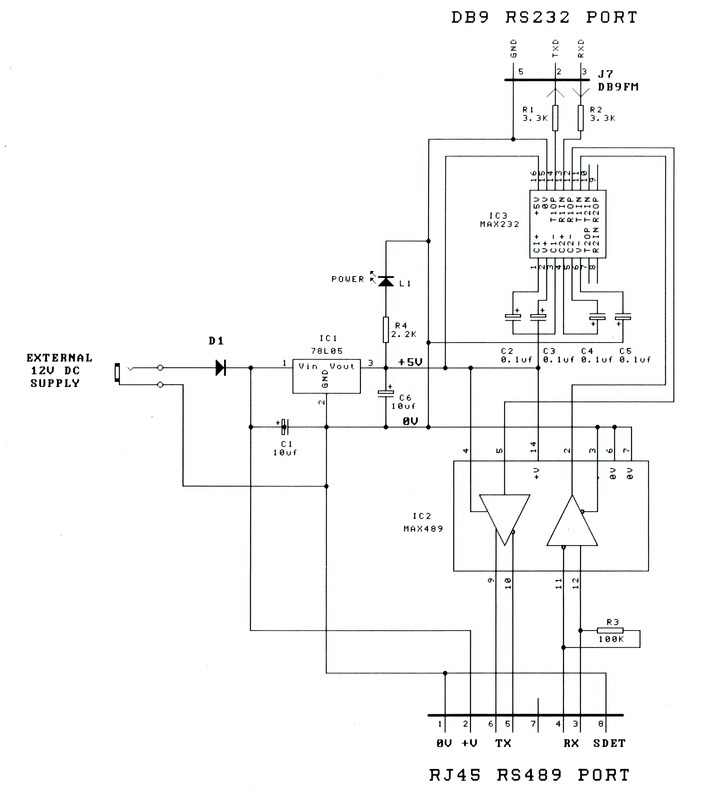_
An RS232 to RS422/485 Serial Adapter
A compact interface between RS232 and RS422/RS485 signals. Bi-directional and usually encapsulated in a tough heatshrink sleeve. RS232 side is via a DB9 connector RS422 side is via RJ45 connector. The unit may be externally powered via 12 volt plug pack (not included), or via a DC connection to the RS485 side.
An RS232 to RS422/485 Serial Adapter
A compact interface between RS232 and RS422/RS485 signals. Bi-directional and usually encapsulated in a tough heatshrink sleeve. RS232 side is via a DB9 connector RS422 side is via RJ45 connector. The unit may be externally powered via 12 volt plug pack (not included), or via a DC connection to the RS485 side.
What is RS232?
This is an international standard for transmitting serial data to or from a computer system. Data speeds are much slower than the modern USB format, but it remains a popular and robust interface standard. RS232 data traffic is usually in the range of 1200 to 19200 baud.
A common ground signal is established between two electronic systems, then a second Transmit Data and third Receive Data connection is added to enable simultaneous communications in two directions. the data connections will have a D.C. voltage on them, usually 9V, and the polarity will reverse from Positive to Negative at a high rate as data is being sent. Depending upon the data (baud) rate, the signals may be transmitted in a cable from 50 to 100 metres only. (Beyond these lengths the inherent capacitance in a cable tends to round-off and distort the data beyond where it can be read properly.)
There were two common electrical connections used, There was the 25 pin DB25 standard and the more common 9 pin DB9 standard. RS232 also supported about four extra lines called 'Handshaking lines' that would change polarity from time-to-time as control signals to let a computer know that the remote system or printer was present and had sufficient paper etc.
Inside a computer or microprocessor, data is sent and received in a 0V to +5V signal format, but to the outside world, RS232 uses the reverse polarity +9V to -9V format as can be seen on the image below:
A common ground signal is established between two electronic systems, then a second Transmit Data and third Receive Data connection is added to enable simultaneous communications in two directions. the data connections will have a D.C. voltage on them, usually 9V, and the polarity will reverse from Positive to Negative at a high rate as data is being sent. Depending upon the data (baud) rate, the signals may be transmitted in a cable from 50 to 100 metres only. (Beyond these lengths the inherent capacitance in a cable tends to round-off and distort the data beyond where it can be read properly.)
There were two common electrical connections used, There was the 25 pin DB25 standard and the more common 9 pin DB9 standard. RS232 also supported about four extra lines called 'Handshaking lines' that would change polarity from time-to-time as control signals to let a computer know that the remote system or printer was present and had sufficient paper etc.
Inside a computer or microprocessor, data is sent and received in a 0V to +5V signal format, but to the outside world, RS232 uses the reverse polarity +9V to -9V format as can be seen on the image below:
What is RS232 / RS485?
The RS232 / RS485 standard is a variation on the RS232 standard where the signal does not rely upon a common earth, but there are a balanced pair of wires for both Send and Receive. Each pair has a small, but constant current flow, with the polarity of the current alternating with data being sent. This has the advantage of being able to operate within much longer cables than the RS232 and range may be extended to 1200 metres.
Therefore the RS232 connections are often used for short-range communications and RS422 / RS485 standard is common in the industrial world where signals and instruments must work in noisy environments over longer cable runs. (RS485 is similar to RS422 except for an additional feature where loop current flow may be halted during certain standby conditions.)
Therefore the RS232 connections are often used for short-range communications and RS422 / RS485 standard is common in the industrial world where signals and instruments must work in noisy environments over longer cable runs. (RS485 is similar to RS422 except for an additional feature where loop current flow may be halted during certain standby conditions.)
Introducing the SM231 Adapter
The SM231 adapter accepts the Ground, Transmit and Receive data lines of a standard 9-Pin RS232 connection and converts it to the balanced Transmit and Receive data lines of the RS422/RS485 standard. As may be observed from the schematic diagram below, the unit may be powered by the addition of a 12V Plug Pack into a common 5.5mm DC power socket, or it may be powered by a remote system that feeds 12VDC down the 8-wire cable to the common RJ45 plug.
This adapter unit is used as a standard item on several Alian Electronics products and is available for separate sale.
This adapter unit is used as a standard item on several Alian Electronics products and is available for separate sale.
Click on the link below to download this Product Information .
| sm231_rs232_adapter_flyer.pdf | |
| File Size: | 441 kb |
| File Type: | |
_________________________________________________________________________________________________________________
PRICING INFORMATION
SM231 RS232 to RS422 Adapter (Does not include 12V power supply)
Qty 1-9 $75.50
Qty 10+ $68.00
(last updated April 2023)
_________________________________________________________________________________________________________________
PRICING INFORMATION
- Payment can be made to Alian Electronics via EFT or Pay Pal
- All prices in $AUD and do not include the cost of freight. (Click HERE to view the Freight Information page)
- When buying from within Australia add 10% GST
- (Overseas sales are GST Free, but depending upon local policy, you may need to pay tax/duty for goods to be released by your Customs)
- When buying from within Australia by Pay Pal, add 2.4% for Pay Pal transaction fee.
- When buying from Outside Australia by Pay Pal add 3.6% for Pay Pal transaction and currency conversion fee.
- (When buying from Outside Australia using Telegraphic Transfer ( TT ) the buyer will pay transaction fees with their bank.)
- Transaction details, Freight & other charges will be shown on a Proforma Invoice supplied to you before you pay.
SM231 RS232 to RS422 Adapter (Does not include 12V power supply)
Qty 1-9 $75.50
Qty 10+ $68.00
(last updated April 2023)
_________________________________________________________________________________________________________________


